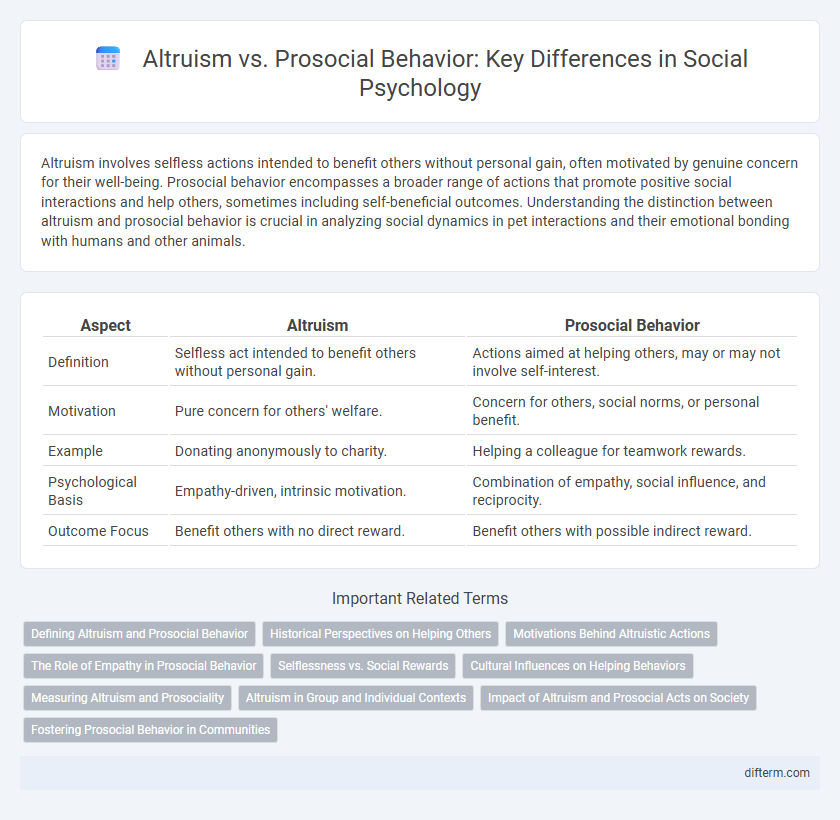Altruism involves selfless actions intended to benefit others without personal gain, often motivated by genuine concern for their well-being. Prosocial behavior encompasses a broader range of actions that promote positive social interactions and help others, sometimes including self-beneficial outcomes. Understanding the distinction between altruism and prosocial behavior is crucial in analyzing social dynamics in pet interactions and their emotional bonding with humans and other animals.
Table of Comparison
| Aspect | Altruism | Prosocial Behavior |
|---|---|---|
| Definition | Selfless act intended to benefit others without personal gain. | Actions aimed at helping others, may or may not involve self-interest. |
| Motivation | Pure concern for others' welfare. | Concern for others, social norms, or personal benefit. |
| Example | Donating anonymously to charity. | Helping a colleague for teamwork rewards. |
| Psychological Basis | Empathy-driven, intrinsic motivation. | Combination of empathy, social influence, and reciprocity. |
| Outcome Focus | Benefit others with no direct reward. | Benefit others with possible indirect reward. |
Defining Altruism and Prosocial Behavior
Altruism refers to actions intended to benefit others without expectation of personal gain, often driven by genuine selflessness. Prosocial behavior encompasses a broader range of voluntary actions aimed at helping others, which may include altruistic acts as well as behaviors motivated by social norms or personal rewards. Understanding the distinction between altruism and prosocial behavior is crucial for studying social dynamics and the underlying motivations of human cooperation.
Historical Perspectives on Helping Others
Historical perspectives on helping others reveal that altruism was initially viewed as selfless concern for the welfare of others, emphasizing actions without expectation of personal gain. Early psychological theories, such as those by Auguste Comte and later social psychologists like Batson, distinguished altruism from prosocial behavior, which includes any voluntary action intended to benefit another, encompassing both selfless and self-interested motives. Over time, research expanded to recognize prosocial behavior as a broader category that integrates evolutionary biology, social norms, and cognitive processes influencing the motivation to help.
Motivations Behind Altruistic Actions
Altruistic actions are primarily driven by intrinsic motivations such as empathy, compassion, and a genuine desire to help others without expecting rewards. Prosocial behavior encompasses a broader range of motivations, including social approval, reciprocity, and personal benefit alongside altruism. Understanding the psychological and neurological bases reveals that altruistic motivation often activates brain regions associated with emotional empathy and moral reasoning.
The Role of Empathy in Prosocial Behavior
Empathy plays a crucial role in driving prosocial behavior by enabling individuals to understand and share the feelings of others, which increases the likelihood of helping actions. Neuroscientific studies identify mirror neurons as key components in empathic responses that motivate altruistic acts without expecting personal gain. Research in social psychology consistently shows that higher empathy levels correlate with increased prosocial behaviors such as volunteering, charitable donations, and cooperative problem-solving.
Selflessness vs. Social Rewards
Altruism involves selfless actions performed without expectation of personal gain, driven purely by concern for others' well-being. Prosocial behavior encompasses a broader range of acts that benefit others and society, often motivated by anticipated social rewards such as approval or reciprocity. Understanding the distinction between altruism's intrinsic selflessness and prosocial behavior's extrinsic incentives is crucial for studies in social psychology and human motivation.
Cultural Influences on Helping Behaviors
Cultural influences significantly shape altruism and prosocial behavior by defining social norms and expectations for helping others. Collectivist cultures emphasize group harmony and community welfare, promoting helping behaviors that prioritize the needs of the in-group. Individualistic cultures, however, often encourage autonomous decision-making, resulting in prosocial acts motivated by personal values and empathy rather than social obligation.
Measuring Altruism and Prosociality
Measuring altruism involves assessing selfless actions performed without expectation of personal gain, often using economic games like the Dictator or Ultimatum Game to quantify willingness to share resources. Prosocial behavior encompasses a broader range of voluntary actions intended to benefit others, such as helping, sharing, or comforting, which are evaluated through observational studies, self-reports, and experimental tasks. Advances in neuroimaging and behavioral economics provide precise tools to distinguish between genuine altruistic motives and socially influenced prosocial behaviors in diverse social contexts.
Altruism in Group and Individual Contexts
Altruism in group contexts often involves selfless actions aimed at benefiting the entire collective, driven by shared goals and social cohesion. In individual contexts, altruism is motivated by personal moral values and empathy, leading to helping behaviors without expectation of reciprocity. Understanding the distinction between group-based altruism and individual altruistic acts highlights the different psychological mechanisms underlying prosocial behavior.
Impact of Altruism and Prosocial Acts on Society
Altruism and prosocial behavior significantly enhance social cohesion by fostering trust and cooperation among individuals. Acts such as volunteering, charitable giving, and community support contribute to improved mental health and well-being while reducing social inequalities. These behaviors promote a resilient society by encouraging empathy and collective responsibility, crucial for addressing global challenges.
Fostering Prosocial Behavior in Communities
Fostering prosocial behavior in communities involves encouraging actions that benefit others and promote social cohesion, distinct from altruism which emphasizes selfless concern for others. Community programs that emphasize cooperation, empathy, and shared goals can effectively nurture prosocial behavior by creating environments where individuals feel valued and motivated to contribute. Research shows that consistent positive reinforcement and inclusive participation significantly enhance prosocial actions, leading to stronger, more resilient social networks.
altruism vs prosocial behavior Infographic

 difterm.com
difterm.com